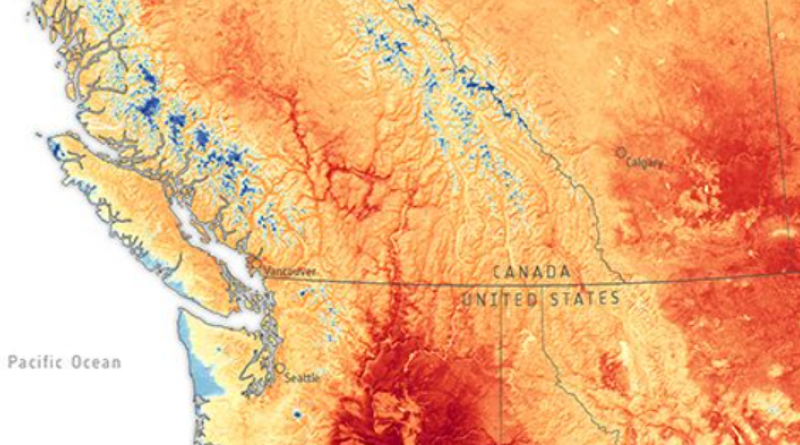BREAKING (The Energy Mix) :Deadly Western Heat Dome 'Virtually Impossible' withour Climate Change.

Less than a week after a deadly “heat dome” devastated western Canada and the U.S. Pacific Northwest and burned Lytton, B.C. to the ground, an international science team is reporting that the blistering conditions would have been “virtually impossible” without climate change.
“Climate change, caused by greenhouse gas emissions, made the heat wave at least 150 times more likely to happen,” the World Weather Attribution Network said in a release.
“An event such as the Pacific Northwest 2021 heat wave is still rare or extremely rare in today’s climate, yet would be virtually impossible without human-caused climate change,” the 27-member research team declared in a paper published late yesterday. “In the most realistic statistical analysis the event is estimated to be about a 1 in 1000 year event in today’s climate,” but “as warming continues, it will become a lot less rare.”
They add that the estimate of hundreds of premature deaths in the heat wave to date is “alarming”, but “likely a severe undercount” until health statisticians have a chance to review mortality data and factor in the impact for people with underlying conditions.
“What we are seeing is unprecedented,” said Friederike Otto, associate director of Oxford University’s Environmental Change Institute. “You’re not supposed to break records by four or five degrees Celsius (seven to nine degrees Fahrenheit). This is such an exceptional event that we can’t rule out the possibility that we’re experiencing heat extremes today that we only expected to come at higher levels of global warming.”
“While we expect heat waves to become more frequent and intense, it was unexpected to see such levels of heat in this region,” added Geert Jan van Oldenborgh, senior researcher at the Royal Netherlands Meteorological Institute. “It raises serious questions whether we really understand how climate change is making heat waves hotter and more deadly.”
The study results, based on a comparison with historical climate records, “provide a strong warning: our rapidly warming climate is bringing us into uncharted territory that has significant consequences for health, well-being, and livelihoods,” the scientists said. “Adaptation and mitigation are urgently needed to prepare societies for a very different future. Adaptation measures need to be much more ambitious and take account of the rising risk of heat waves around the world, including surprises such as this unexpected extreme.”
And “greenhouse gas mitigation goals should take into account the increasing risks associated with unprecedented climate conditions if warming would be allowed to continue.”
Every heat wave that takes place today “is made more likely and more intense by climate change,” the WWAN release explained. But this time, “the extreme temperatures experienced were far outside the range of past observed temperatures, making it difficult to quantify exactly how rare the event is in the current climate and would have been without human-caused climate change.”
They did, however, conclude that it would have been “virtually impossible” without the climate-warming impacts of human activity.
The review covered a stretch of B.C., Oregon, and Washington State that included the cities of Vancouver, Portland, and Seattle, with a combined population of more than nine million people who sweltered and suffered through temperatures as high as 49.6°C. It looked at the “slow-moving strong high pressure system” that settled in over the area, bringing warm, dry air along with clear skies that led to higher near-surface temperatures.
The science team came up with two possible pathways by which climate change made the extraordinary heat more likely. One possibility is that climate change, combined with the heat dome plus pre-existing drought, made the heat wave more likely, but still a “very unusual event,” the release states. The second is that the global climate system “has crossed a non-linear threshold where a small amount of overall global warming is now causing a faster rise in extreme temperatures than has been observed so far.”
The scientists called for further research to sort out which interpretation is right.
“Based on this first rapid analysis, we cannot say whether this was a so-called ‘freak’ event…that largely occurred by chance, or whether our changing climate altered conditions conducive to heat waves in the Pacific Northwest, which would imply that ‘bad luck’ played a smaller role and this type of event would be more frequent in our current climate,” the scientists write.
But “in either case, the future will be characterized by more frequent, more severe, and longer heat waves, highlighting the importance of significantly reducing our greenhouse gas emissions to reduce the amount of additional warming.”
While the Attribution Network focused its attention on the western heat dome, a new modelling study published this week in the journal Nature Communications points to greenhouse gas emissions and land use changes as “a key factor in extreme precipitation events such as flooding and landslides around the world,” The Guardian reports.
“Up till now, work in this field has been restricted to countries, rather than applied globally,” the news story explains. In the new study, a UCLA research team used machine learning to tell a wider story. “By examining multiple data sets of observed precipitation, the researchers were able to build a global picture, and found evidence of human activity affecting extreme precipitation in all of them.”
While some areas see increased drought as a result of climate change, “the dominant mechanism [driving extreme precipitation] for most regions around the world is that warmer air can hold more water vapour,” said lead researcher Gavin Madakumbura. “This fuels storms.”
July 2021
The Energy Mix




